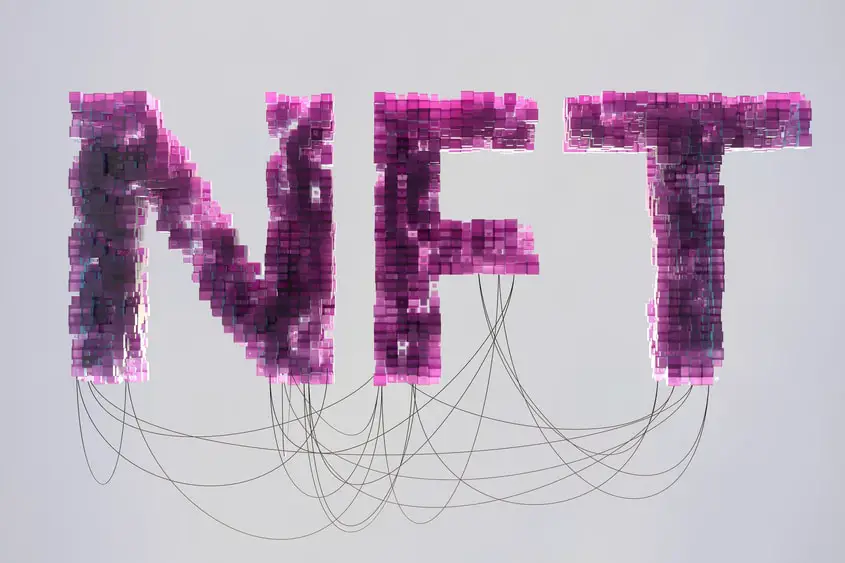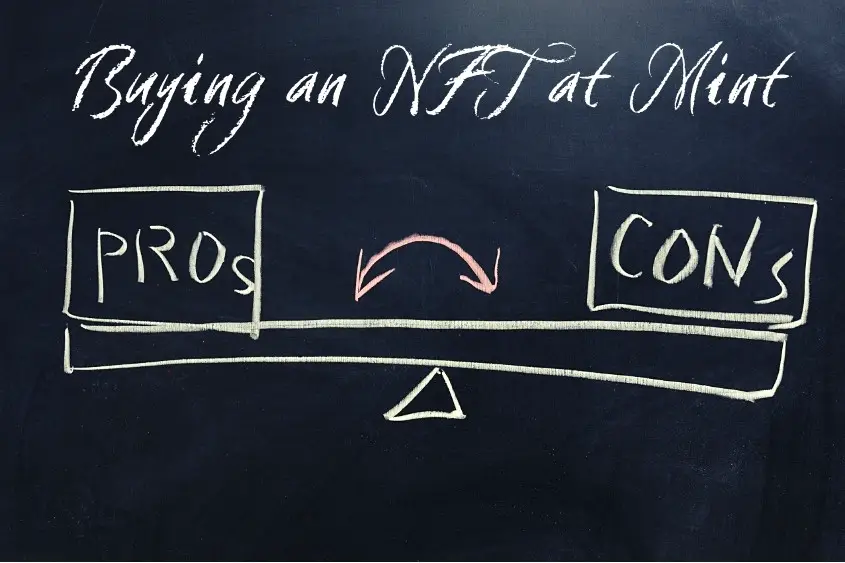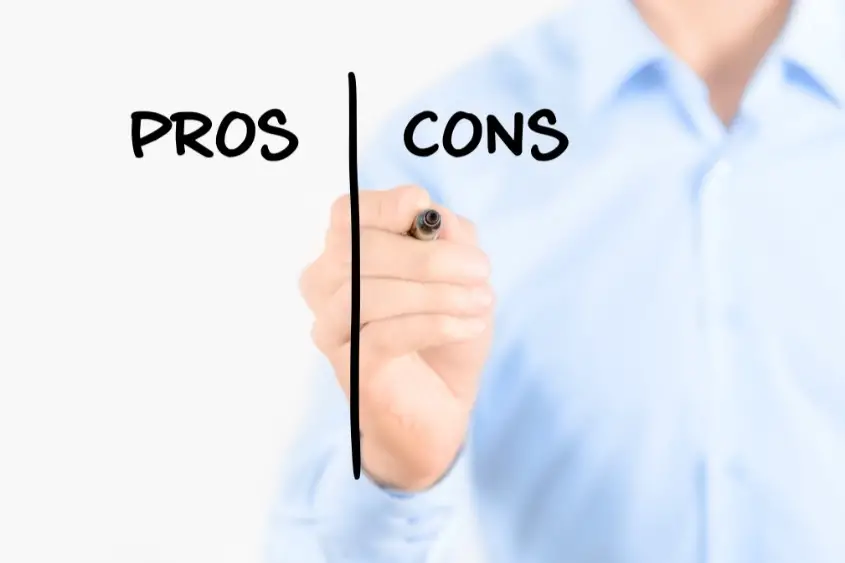Many people are curious to know how to purchase their own NFTs, or even create their own. Regardless, the term to create an NFT and sometimes purchase an NFT is generally referred to as minting.
Minting an NFT is the process of publishing a digital file on the blockchain so it can be bought, sold, and traded. The term minting is generally used to describe the creation process of an NFT. It’s also used to describe the act of purchasing a non-fungible token directly from a smart contract.
This term might be talked about in different contexts, it really depends if you are creating an NFT or purchasing a new NFT. Let’s talk about what minting an NFT really means.
What Is Minting an NFT?
Minting an NFT refers to publishing a unique token on the blockchain. As a creator, you mint an NFT to make it available to sell to others. As a consumer, you might actually mint an NFT from a contract, which is then revealed after you buy it. Allow me to explain the difference between the two.

Mint an NFT as a creator
Minting an NFT as a creator means that you are publishing a single or an entire collection of NFTs onto the blockchain. From there, others will be able to purchase your NFT on your own website or on secondary marketplaces.
Mint an NFT as a consumer
Minting an NFT from a consumer standpoint means that you are buying an NFT. Some creators will make contracts that allow the consumers to publish their NFT upon purchase. Essentially allowing the consumer to become the original owner of the NFT, rather than the creator of the NFT.
In both scenarios, the NFT itself is still going through the technical process of being published on the blockchain.
Is Minting an NFT the Same As Buying It?
Minting an NFT is the process of uniquely publishing your token on the blockchain to make it purchasable. Buying an NFT means the digital file has already been published to the blockchain. When you buy an NFT, you are paying for the token itself along with the associated transaction fee.
That said, you can mint an NFT at the same time you purchase it. So, not only are you publishing the item to the blockchain, but you’re also paying to own it and to have it transferred into your ownership.
This is where much of the confusion comes from when differentiating between minting an NFT and buying it.
Factors to Consider Before Minting NFTs
If you are thinking about minting your own NFT, make sure to consider these important factors below.
1. Blockchain Platform
The most popular NFT blockchain is Ethereum. Many iconic NFT projects and digital collectibles that we know today were created on Ethereum. CryptoPunks and Bored Ape Yacht Club are two primary examples. Hence, the Ethereum blockchain has grown in popularity as a result.
With that, there are numerous blockchains that support the NFT minting process. Below of some of the best blockchains to make NFTs.
- Ethereum
- Solana
- Polygon
- Tezos
- Cardano
- Binance Smart Chain
- Arbitrum
- WAX
- Tron
- EOS
2. Blockchain Compatibility
Every blockchain is different. That said, not all of the networks are compatible with one another. For example, you can’t transfer an Ethereum NFT to the Solana network. Rather, it has to remain on Ethereum.
But there are ways to move NFTs between chains using a wrapper. That said, not all NFTs can be wrapped and transferred to other blockchains so easily. So, it’s important to choose a blockchain that you plan to stick with for the foreseeable future.
3. Cost
Although the Ethereum blockchain is the most popular and trusted network, it’s also one of the most costly due to its consensus mechanism. This mechanism ensures the network’s scalability, security, efficiency, and overall functionality.
And although efforts are being made to reduce the cost to create a token on Ethereum, it can still be expensive. But, not to worry. Networks like Solana and Tezos have different consensus mechanisms, making them both affordable options that are pennies on the dollar compared to Ethereum.
4. NFT Marketplace
Choosing a reputable marketplace is important whether you are buying, selling, or minting an NFT. Mainly because you want to make sure the marketplace you use is legit so you don’t fall victim to a scam. Of course, different blockchains have different marketplaces.
The most popular NFT marketplace is Opensea. Unlike most marketplaces, Opensea actually supports 7 separate blockchains:
- Ethereum
- Polygon
- Klaytn
- Solana
- Arbitrum
- Optimism
- Avalanche
Point is, make sure you choose a blockchain that has reputable NFT marketplaces. Some of the newer blockchain networks only have a couple of marketplaces, hence, they may not be as trustworthy.
How to Mint an NFT
1. Create your digital item
Before you can create your own NFT, first you have to create a digital file that you will publish to the blockchain. This file can be an image, video, audio, or a combination of such. However, keep in mind there are upload limitations to what you can
2. Buy some crypto
To create a digital asset you will have to use cryptocurrnecy to pay for any blockchain-related transaction fee. Each blockchain uses its own native crypto, so you need to make sure you buy the correct currency for the blockchain you’re using.
For example, Ethereum’s native cryptocurrency is ETH. So, to create an NFT on Ethereum, you’re going to need to purchase some ETH via a trusted exchange like Coinbase.
3. Get a crypto wallet
To use your funds and store your created NFTs, you need to get a crypto wallet. The most popular wallet for Ethereum is MetaMask. But, if you’re looking for a more robust wallet that works with multiple blockchains and also happens to be the most secure, I highly reccomend getting a hardware wallet.
4. Publish your asset to the blockchain
Once you have your wallet setup and your blockchain’s native crypto loaded in it, you’re ready to publish your digital asset to the blockchain. The process is largely the same on most NFT marketpalces. Of course, there will be some variance between marketplace.
Below I’ll show you how to create an NFT on Opensea—the largest NFT marketplace.
Minting an NFT on Opensea
Minting a non-fungible token is a lot easier than you might think. In fact, you can publish a token for free on using Opensea. Follow these three quick and easy steps below to make your own unique digital items.

1. Log in to the marketplace using your crypto wallet
If you already have a wallet that’s compatible with Opensea, go to the marketplace and sign in.
2. Tap create and fill in the NFT’s details
To begin creating your NFT, tap “Create” in the upper right of the screen on the homepage. You will then be directed to the “Create New Item” page. From here, creating your NFT is very straightforward.
Follow the prompts on-screen to create your unique digital item.
3. Review the details, before creating your NFT for free
After you have filled out all the details for your NFT, hit Create. Your NFT will automatically be created for free. This is called Lazy Minting. Basically, your NFT isn’t minted on the blockchain until someone decides to purchase it.
Upon purchasing your item, the buyer will pay the gas fee to publish it onto the blockchain.
Don’t worry if you discover that you’ve made a mistake when you created your item, you can still edit it as long as it hasn’t been sold and as long as you don’t freeze the metadata.
How to Make Your Own NFT Smart Contract
If you don’t want to create an NFT using a marketplace’s smart contract, you can hire a developer to write you your own smart contract which allows consumers to mint an NFT from your own website. Or you can write your own custom smart contract using a no-code solution like NiftyKit.
If you have no interest in the actual creation process of minting NFTs, then investing in a developer to make your smart contract for you is likely your best option.
On the flip side, if you want to learn how to create your own smart contract but you have few technical skills, using no-code services like NiftyKit is a great choice.
How Long Does It Take to Mint an NFT?
Minting an NFT can take anywhere from 5 minutes for a single NFT, up to several weeks for an entire collection with a custom smart contract. If you are minting your own NFT using an NFT marketplace, the process is quick. If you start an entire collection from scratch, it’ll take longer.
With that, there are various steps to consider when determing how long it takes to design and publish an NFT.
- Creation of the asset. Are you creating a one-off piece of art or are you designing an entire collection? Regardless of what you plan on creating, the time will vary depending on many factors.
- Smart contract development. Do you plan to create an NFT using a marketplace, or are you going to hire a developer to write a custom smart contract for you? Custom smart contracts require more work compared to a generic smart contract found on a marketplace.
Should I Buy an NFT at Mint?
There is no simple answer to whether you should purchase NFTs at ‘mint’ or on the secondary market. Experts tend to advise doing a bit of both with prior research at hand. There are potential pros and cons, as well as risk factors, involved in making these decisions. As a result, it is wise to approach your decision on a case-by-case basis.

Buying at mint means you get the NFT for a set price before the market determines the value. This can save you a lot of money, and make you a big profit if done right. However, the market may determine the NFT is worthless after mint, meaning you could save money by purchasing on secondary.
Generally speaking, if an NFT is being released by a well-known person or brand that is respected, you might be better off purchasing at mint for a lower price. Likewise, if the creator is largely unknown, you could benefit from waiting to purchase on secondary to see how the market reacts to the product or service being offered.
Buying an NFT at Mint vs a Secondary Marketplace
When you go to buy a non-fungible token, you might wonder if it’s better to buy an NFT at mint or from a secondary marketplace. Below we review the pros and cons of each.
Pros and Cons of Buying NFTs at Mint
There are many ups and downs when it comes to buying an NFT at the mint. Here are some of the main pros and cons.

Pros:
- Profit from being amongst the first to buy: It can be advantageous to be among the first to buy new tokens. In fact, the earliest investors can get NFTs at the lowest possible price. As a result, you are in an excellent position to increase the return on your NFT investment.
- Gain exclusive access to DAOs and other perks of being first: Buying an NFT can give you an edge in the community aspect. For example, instances in which NFTs might provide token holders entries into the project’s DAO can culminate in investors receiving stakes in where the project might go.
Cons:
- Risk of decrease in value after mint: The speculative market is one of the main reasons why minting new NFTs entails significant risk. As it happens, there is no guarantee that the value of your product will go up over time. Incidentally, you might as well face circumstances where there is a steep drop in price right after minting.
- High gas fees: There are times when the entry price could go substantially up due to increased network activity. At times, there can be too many people at once trying for a spot in the mint. As a result, it can raise gas fee rapidly.
Pros and Cons of Buying NFTs on Secondary Marketplaces
Secondary marketplaces are also a popular option for people who want to invest in NFTs. Since buyers can get a peek into the demands of certain assets, secondary markets can also be a place of interest for investors with insights. Here is an extensive list of the pros and cons of buying NFTs on secondary marketplaces.

Pros:
- Record of market history: If you are a buyer looking to purchase NFTs on the secondary market, you will gain knowledge of the relevant transaction history and price changes. As a result, secondary markets allow you to evaluate how many times an individual token has changed hands. In addition, the information allows buyers to analyze when it is the right time to dive into the market.
- Decreased purchasing price: Secondary markets can be really helpful in bringing down the buyers’ overall cost of buying an NFT. Since the marketplaces allow customers to time their purchases, buyers can buy products when the network activity is relatively low. As a result, consumers can save money by only paying a gas fee.
Cons:
- Huge fluctuations in market price: There are instances where certain NFTs become popular overnight, resulting in a drastic price increase in the market, meaning you are stuck paying a premium to get an NFT.
- Not as great profit margins: Considering NFTs are sometimes cheapest at mint, your profit margin might be negatively affected as a result. More often than not, those who flip NFTs choose to purchase multiple NFTs at the time of mint, that way they can make as much profit as possible on secondary.
Final thoughts
Before minting NFTs or purchasing them on the secondary market, buyers must thoroughly assess their risks and investment strategies. In general, minting tends to be cheaper than buying on secondary, however, this could also bite you in the butt if you don’t do your own research before purchasing.
In recent years, NFTs have become a valuable source of revenue. Creators who like to make digital art can use NFTs to reach a much wider audience than ever before. As a result, it is absolutely essential to ponder things over with the utmost consideration and sincerity before making a decision on investing in NFTs. This goes for both creators and consumers.

5 thoughts on “What Is Minting an NFT? (+ How to Mint NFTs)”
Comments are closed.